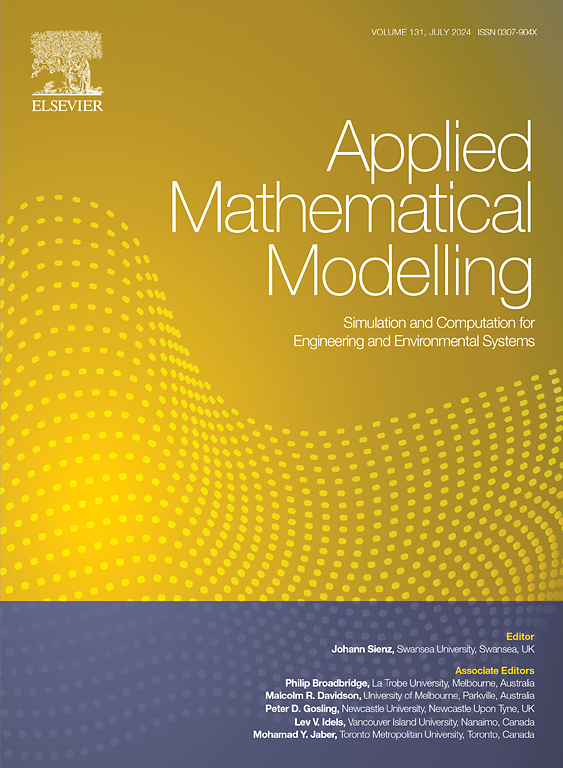Semi-analytical FEM for modelling 3D guided waves scattering in an infinite plate
IF 4.4
2区 工程技术
Q1 ENGINEERING, MULTIDISCIPLINARY
引用次数: 0
Abstract
Reconstructing true flaw shapes in three-dimensional (3D) structures using ultrasonic guided waves is still a challenging problem nowadays. Therefore, a thorough and visual analysis of 3D guided waves scattering interacting with defects is urgently needed. The 3D semi-analytical finite element method (FEM) proposed in this paper can not only have advantages on mesh reduction and need no absorption medium or perfectly matched layer to suppress the reflected waves compared to traditional FEM, but also can directly obtain the scattering coefficients of each guided wave to visualize the scattering phenomena and mechanism. Moreover, the virtual non-reflecting boundary is processed perfectly, thus eliminating all spurious reflected waves. A three-step strategy of this method is performed as follows: Firstly, the 3D scattered waves at the virtual boundary are represented by a series of Lamb and SH cylindrical guided waves of Bessel function form with unknown scattering coefficients; Secondly, utilizing the mode orthogonality, the unknown tractions at the virtual boundary are expressed in terms of the unknown scattering displacements at the virtual boundary via scattering coefficients; Thirdly, this linear relationship at the virtual boundary can be assembled into the global FEM matrix to solve the problem. This method is implemented to analyze the scattering phenomena due to symmetric defects in a 3D infinite plate. The correctness and effectiveness of the proposed method is finally validated compared with existing methods, and the scattering mechanisms of different defect types, shapes and sizes are discussed in detail.
三维导波在无限大板中的散射半解析有限元模拟
利用超声导波重建三维结构的真实缺陷形状仍然是一个具有挑战性的问题。因此,迫切需要对三维导波散射与缺陷的相互作用进行深入、直观的分析。本文提出的三维半解析有限元法(FEM)与传统有限元法相比,不仅具有网格减少的优点,不需要吸收介质或完全匹配层来抑制反射波,而且可以直接获得每个导波的散射系数,从而直观地显示散射现象和机理。此外,对虚拟非反射边界进行了完美的处理,从而消除了所有的假反射波。该方法分三步进行:首先,将虚拟边界处的三维散射波表示为一系列散射系数未知的贝塞尔函数形式的Lamb和SH圆柱导波;其次,利用模态正交性,将虚拟边界处的未知牵引力通过散射系数表示为虚拟边界处的未知散射位移;第三,将虚拟边界处的线性关系组合成全局有限元矩阵求解问题。应用该方法分析了三维无限大板中对称缺陷引起的散射现象。最后通过与现有方法的比较,验证了所提方法的正确性和有效性,并详细讨论了不同缺陷类型、形状和尺寸的散射机理。
本文章由计算机程序翻译,如有差异,请以英文原文为准。
求助全文
约1分钟内获得全文
求助全文
来源期刊

Applied Mathematical Modelling
数学-工程:综合
CiteScore
9.80
自引率
8.00%
发文量
508
审稿时长
43 days
期刊介绍:
Applied Mathematical Modelling focuses on research related to the mathematical modelling of engineering and environmental processes, manufacturing, and industrial systems. A significant emerging area of research activity involves multiphysics processes, and contributions in this area are particularly encouraged.
This influential publication covers a wide spectrum of subjects including heat transfer, fluid mechanics, CFD, and transport phenomena; solid mechanics and mechanics of metals; electromagnets and MHD; reliability modelling and system optimization; finite volume, finite element, and boundary element procedures; modelling of inventory, industrial, manufacturing and logistics systems for viable decision making; civil engineering systems and structures; mineral and energy resources; relevant software engineering issues associated with CAD and CAE; and materials and metallurgical engineering.
Applied Mathematical Modelling is primarily interested in papers developing increased insights into real-world problems through novel mathematical modelling, novel applications or a combination of these. Papers employing existing numerical techniques must demonstrate sufficient novelty in the solution of practical problems. Papers on fuzzy logic in decision-making or purely financial mathematics are normally not considered. Research on fractional differential equations, bifurcation, and numerical methods needs to include practical examples. Population dynamics must solve realistic scenarios. Papers in the area of logistics and business modelling should demonstrate meaningful managerial insight. Submissions with no real-world application will not be considered.
 求助内容:
求助内容: 应助结果提醒方式:
应助结果提醒方式:


